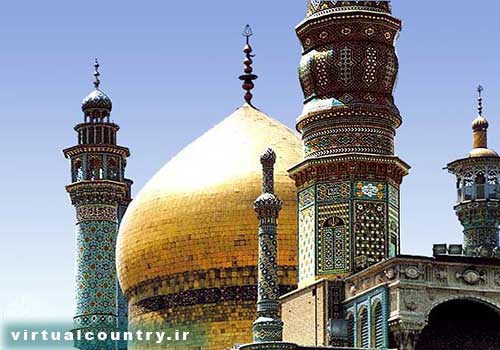Hazrat Ma'soomeh Holy Shrine, Qom
The aggregate of the Holy Shrine of Hazrat Ma'soomeh is in the city center of Qom, and is considered to be one of the largest and most valuable relics of Islamic architecture of Iran and the world which bears precious remnants from various centuries. This aggregate has been constructed on mausoleum of Hazrat Fatemah reputedly known as Ma'soomeh the daughter of Imam Moosa Kazem (AS), and sister of Imam Reza (AS). After Hazrat Ma'soomeh's sacred corpse was laid to rest, Moosa Ebne Khazraj erected a straw mat shelter over the tomb. This disintegrated with the passage of time and later the inhabitants constructed a tower like structure made of plaster and brick on the sacred tomb. This was the reason that when any woman from Moosa Ebne Mabraqeh household was passed away, the was buried alongside the sacred tomb of Hazrat Ma'soomeh, thus a cupola was formed which was the burial site of four persons. In due time two other cupolas were erected alongside the prior ones. In the year 447 AH., Mir Abol Fazl, the minister of Toqrol, who was a pious person erected a cupola rising to the height of 14 m. upon the same three other cupolas.In the Safavid period, the Holy Shrine of Hazrat Ma'soomeh had four courtyards placed in succession, and pilgrims used to enter from one and exit from the other. In Qajar era, Fathali Shah paid special attention to this sacred vicinity and most of its current adornments are related to the said period. Presently the Holy Shrine consists of the following structures: The sacred shrine: The current structure was constructed by Shah Begum in the year 925 AH. It is an irregular octagon with eight platforms. After this part there is the dome and ceiling adorned with decorative arches. There is a beautiful inscription throughout engraved in the 'Tholth' script in a gilded form on a background of turquoise and white tiles. These verses are sacred. There is also another inscription in embossed 'Tholth' script and worked with plasterwork with verses from the Holy Qoran. This inscription belongs to the date of 1251 AH. On the structure is the dome rising to an elevation of 16 m. which was constructed by the orders of Fathali Shah in place of the former dome in the years 1215-1218 AH. Due to the fact that the sacred tomb is placed between two sepulchres today, is hidden from sight. This tomb is worked with beautiful tile work in the mid 7th century AH., and such adornment is worthy of praise and an excellent piece of craftsmanship. To the south of which after crossing the southern porch, there is a large dome, and this area is commonly known as the 'woman's courtyard', and now is called the 'mosque museum'. The domed ceiling and altar are worked in artistic tile work, besides the epigraphs which adorn it. In the northern direction of this is the gold porch, constructed by the efforts of Shah Begum, the daughter of Shah Esmail in the year 925 AH. This porch has tile worked cornices related to the Safavid era and two minarets. To the east of the shrine is also a porch reaching a height equivalent to the gold porch known as the 'Mirror Porch' and the said displays a fine master piece of art and architecture of the Qajar period. Facing this porch is a covered area which excels in beauty. The new courtyard: The same is located to the east of the shrine, and was constructed by Mirza Ali Asqar Khan Amin-ol-Soltan. Surrounding this courtyard are more than 30 large and small mausoleums, the most important of which is his tomb. This courtyard is in two connected segments. The larger sector is an irregular octagon, and the smaller section is in form of a projection amidst the eastern side and is of five sides. Around the courtyard to the upper portion of the porches there are inscriptions of sun baked brick tiles with azure backgrounds displaying poetic verses. This courtyard, besides its mirror porch has three other porches to the east, north and south. The eastern porch is the most delicately architectured of the three. Its ceiling is worked in an arched style adorned with gilded and colored tiles. On this porch are two minarets and a clock tower. The porch was flanked by two corridors which currently are used as vaults. The new court has three tiled entrances to the east, north and south of the courtyard.The Atiq or old courtyard: This courtyard was built under the instructions of Fath Ali Shah Qajar, in place of the two smaller courtyards of the Safavid era.To the south of this vicinity is the gold porch with porches on two sides of it. On the other sides there are mausoleums, such as that of the two Qajar sovereigns. Surrounding this courtyard and on the porches are inscriptions with poetical verses inspired by the decorative dome in the year 1218 AH. In this courtyard, to the north, is its majestic entrance from the Shah Tahmasb Safavid reign, which is near the Qiasieh School. The northern porch of the courtyard has a vaulted ceiling, but is simple in style otherwise being constructed of gypsum. This is opposite the gold porch. The southern porch however, is a fine relic of the Safavid period adorned with poetical inscriptions.Tombs of the monarchs: In this aggregate there are various tombs belonging to that of monarchs and princes of the Safavid and Qajar periods. These remnants are considered the historical and artistic relics of this vicinity.
